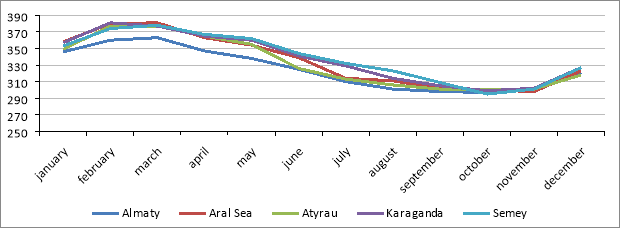Ozone is a gas consisting of three oxygen atoms. Strong oxidizer. There is not much ozone on the surface (about 2–10–8 % by volume). The article is devoted to the identification of the spatial-temporal distribution of ozone. Ozone values were observed in the cities of Almaty, the Aral Sea, Atyrau, Semipalatinsk and Karaganda.As a result of the work, the main regularities of the spatial and temporal distribution of total ozone over Kazakhstan for the period 1974–2004 were revealed.
Keywords: ozone, Dobson unit (DU), maximum, minimum, trend line.
On earth, the concentration of ozone is 6–10 %, and it is not harmful to life due to the small amount of ozone. But ozone is a very active gas. Harmful to living creatures. In fact, the average ozone concentration is 8ml / m3. The main function of the ozone layer is to absorb the harmful ultraviolet rays from the sun absorbed by the sun. Thus, earthly creatures are protected from exposure to the sun. On March 22, 1985, the Vienna Convention for the Protection of the Ozone Layer was adopted. The participating countries agreed on a systematic and fundamental study of ozone-depleting substances to protect the ozone layer. The Montreal Protocol on Substances that Deplete the Ozone Layer was adopted on September 16, 1987 [1].
The problem of ozone is the most important problem of the physical atmosphere, which was only half a century ago. In the 1920s, it was discovered that the composition of the atmosphere was different in the lower and upper layers [2].
S.Cheppen In England in the years 1930–1931. The first thing he proposed was the photochemical theory of ozone (oxygen). He said that the O2 molecule will appear in elastic connection with the O atom. Similarly, the composition of the upper atmosphere and its processes were observed in a short time.
In 1926–1931 New instruments were developed to monitor ozone and determine its vertical position. The optical characteristics of ozone have been identified, and several control points have been discovered that allow a cyclone to control ozone during an anticyclone [3].
The thickness of the ozone layer varies worldwide and is generally thinner near the equator and thicker near the poles. Thickness refers to how much ozone is in a column over a given area and varies from season to season. The reasons for these variations are due to atmospheric circulation patterns and solar intensity. The majority of ozone is produced over the tropics and is transported towards the poles by stratospheric wind patterns. In the northern hemisphere these patterns, known as the Brewer-Dobson circulation, make the ozone layer thickest in the spring and thinnest in the fall.When ozone in produced by solar UV radiation in the tropics, it is done so by circulation lifting ozone-poor air out of the troposphere and into the stratosphere where the sun photolyzes oxygen molecules and turns them into ozone. Then, the ozone-rich air is carried to higher latitudes and drops into lower layers of the atmosphere [4].
In the period from 1974 to 2004, general ozone values were reported in Almaty, the Aral Sea, Atyrau, Karaganda and Semey (Table 1).
Table 1
The ozone values of 1974–2004
|
Years |
Almaty |
Aral Sea |
Atyrau |
Karaganda |
Semey |
|
1974 |
321 |
334 |
- |
337 |
- |
|
1975 |
325 |
339 |
- |
331 |
325 |
|
1976 |
327 |
329 |
343 |
337 |
- |
|
1977 |
334 |
337 |
341 |
357 |
376 |
|
1978 |
317 |
333 |
353 |
337 |
344 |
|
1979 |
326 |
344 |
334 |
322 |
353 |
|
1980 |
332 |
345 |
349 |
348 |
- |
|
1981 |
332 |
345 |
347 |
367 |
- |
|
1982 |
- |
348 |
345 |
305 |
- |
|
1983 |
305 |
- |
336 |
341 |
- |
|
1985 |
319 |
309 |
336 |
339 |
319 |
|
1986 |
322 |
336 |
332 |
342 |
345 |
|
1987 |
330 |
344 |
340 |
347 |
353 |
|
1988 |
323 |
- |
- |
334 |
342 |
|
1989 |
328 |
336 |
336 |
341 |
347 |
|
1990 |
323 |
325 |
326 |
324 |
328 |
|
1991 |
336 |
340 |
336 |
339 |
347 |
|
1992 |
321 |
329 |
331 |
303 |
323 |
|
1993 |
315 |
312 |
312 |
321 |
317 |
|
1994 |
333 |
328 |
322 |
329 |
332 |
|
1995 |
323 |
321 |
304 |
323 |
325 |
|
1996 |
331 |
- |
323 |
349 |
350 |
|
1997 |
323 |
- |
332 |
374 |
344 |
|
2000 |
326 |
- |
326 |
331 |
- |
|
2001 |
320 |
- |
303 |
338 |
343 |
|
2002 |
320 |
- |
347 |
336 |
333 |
|
2003 |
325 |
- |
- |
344 |
343 |
|
2004 |
318 |
- |
- |
339 |
339 |
As shown in table 1, the highest and lowest ozone levels in Almaty are 398 DU and 305 DU. This indicator was observed in 1998 and 1983, respectively. And in 1985, when the Aral Sea was 348 DU, in 1985 a minimum value of 309 DU was recorded. In Atyrau there are 353 DU and 298 DU (1978, 1999). Compared with other stations, in Semey 377 DU and 303 DU (1997, 1992) and 376 DU and 317 DU (1977 and 1993). At each station, ozone is uneven. In some years, reaching a maximum, some years showed a minimum value. In the period 1974–2004. The trend line at 5 stations was different. However, the trend line is similar in Almaty, Karaganda and Semipalatinsk. In recent years, the trend line has fallen in the cities of Aral and Atyrau since 1990.
The trend line for the seasons of all cities is different. The table below shows the average monthly mileage of 5 stations (Table 2).
Table 2
Monthly average of 5 stations
|
Months |
Almaty |
Aral Sea |
Atyrau |
Karaganda |
Semey |
|
january |
346 |
358 |
349 |
357 |
353 |
|
february |
360 |
380 |
377 |
381 |
374 |
|
march |
363 |
381 |
377 |
377 |
378 |
|
april |
347 |
363 |
365 |
365 |
367 |
|
may |
338 |
354 |
355 |
360 |
362 |
|
june |
325 |
339 |
326 |
341 |
344 |
|
july |
310 |
314 |
313 |
329 |
332 |
|
august |
301 |
311 |
306 |
314 |
323 |
|
september |
298 |
302 |
301 |
305 |
309 |
|
october |
297 |
300 |
300 |
299 |
295 |
|
november |
302 |
298 |
301 |
302 |
301 |
|
december |
321 |
323 |
318 |
327 |
327 |
As shown in Table 2, all stations were high in February and March. And from August to November they fall and again in December. The ozone distribution across the station is relative to each other.
The figure below shows the average monthly march of 5 stations (Figure 1).

Figure 1. Monthly average of 5 stations
Figure 1 shows the Aral Sea in March, May, June, July, August and September, and Semipalatinsk, Karaganda, is of high significance. Overall, Almaty has low values compared to other stations over the whole month. Also, in the autumn, all the stations are close to each other at the lowest values. Basically, all the stations are close to each other. Winter trend is similar to the trendline in Almaty, Atyrau and Aral. In December, the trend line in Semipalatinsk and Karaganda increased compared to other months. In spring time, only in Semipalatinsk, the trendline differs from other stations. In this city, the trend line has dropped by 3 months, while the trend line in other cities has not dropped or increased. In the summer, the trend line in Almaty and Aralsk is similar to each other in 3 months. At the Atyrau and Semey stations in June it dropped dramatically. In other months, it has not changed. In the autumn, the trend line on all stations is different. The train line at Alma-Ata station was similar to each other in 3 months, while the Aral Sea trend line dropped three months. At Karaganda and Atyrau stations fell significantly in October. In September, the trend line in Semey was higher than in October and November.
References:
- Buribay E.S Environmental Monitoring, Study Guide. — Almaty, 2013. — P. 31–37.
- Ludchik A. M., Pokatashkin V. I. Climate norm and long-term trend of total ozone over the territory of Belarus // Reports of the National Academy of Sciences of Belarus. 2012.-T. 56. № 3.- B.104–110.
- Zvyagintsev A. M., Ivanova N. S., Kruchenitsky G. M., Kuznetsova N. N., Lezina E. A. Ozone content over the territory of the Russian Federation in 2006 // Meteorology and Hydrology. — 2007. — № 2.- 116 b.
- Tabin, Shagoon (2008). Global Warming: The Effect Of Ozone Depletion. APH Publishing. p. 194. ISBN 9788131303962. Retrieved 12 January 2016.







